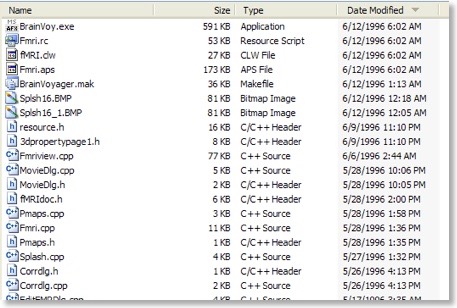BrainVoyager 10th Anniversary

I can hardly believe that already 10 years have passed since I compiled version 1.0 of BrainVoyager! The first build is from June 12 1996 (see above) with an executable name of “BrainVoy.exe”. While Windows 95 allowed using longer file names, it was advisable at that time to use the “8.3” naming scheme to stay compatible with Windows 3.1 and DOS.
I remember starting programming “an fMRI tool” already in November 2005 with a first very extensive programming period starting after Christmas and lasting until early January. The “week between the years” has remained a week of extensive programming of novel projects. The only vivid memory from that week is a relaxed brainstorming session with Claudia about finding a nice name for my little fMRI tool. Yes, I am a great fan of science fiction movies and of real and fictitious space travels and the “Voyager” part of the name was indeed inspired by NASA’s Voyager probe - which recently celebrated its 25th anniversary. When one of us - I don’t know who it was - finally said “BrainVoyager”, we stopped generating words falling asleep with the satisfying feeling to have found the right name.
We presented BrainVoyager 1.0 as a technical demonstration at the second Human Brain Mapping conference in Boston, USA, June 17-June 21. The program achieved an unexpectedly high resonance at that conference. Since that meeting we started to like the HBM conference very much and it was a natural decision to celebrate the 10th anniversary during this years HBM in Florence. What caused the excitement about the program in 1996? I think one important aspect was that BrainVoyager worked under Windows using a modern, easy-to-use graphical user interface. The second aspect probably was that the program worked very fast using standard PC hardware. The third aspect was that the live demonstrations worked out really well - people were amazed and surprised when I calculated cross-correlation maps and volume renderings in a few seconds and, especially, when I changed statistical thresholds in real-time...
A lot has changed over the last 10 years. BrainVoyager 1.0 consisted of a few thousand lines of code and 10 dialogs/windows. BrainVoyager QX 1.7 consists of several hundred thousand lines of code and more than 100 dialogs. A big step was the decision to create a cross-platform version of BrainVoyager. The last Windows-only version was 4.9 followed by the first version of BrainVoyager QX. To guarantee maximal speed, and a native behavior on Windows, Linux and Mac OS X, the new cross-platform code base was implemented with great care and involved a complete rewrite of the user interface code and substantial changes in the core computational routines. As BrainVoyager 1.0, BrainVoyager QX aims to be a comprehensive fMRI software package with an elegant, easy-to-use graphical user interface allowing to perform all relevant analysis tasks with a few mouse clicks and/or scripts. A quite recent important addition is the Plugins interface, which enables everyone to extend the functionality of the software.
The commercialization of BrainVoyager happened in the late nineties when a big scanner manufacturer was seriously interested to acquaint the software. While this deal did not work out, Garching Innovation, a technology transfer company of the Max Planck society, advised us to commercialize the software. It is very clear that without Claudia’s engagement in this endeavor, there would be no company “Brain Innovation” selling and supporting the product. The “Innovation” part in the companies name is actually inspired by the name “Garching Innovation”. Having a little company is very important because it allows us to provide an increasingly sophisticated level of support for the users of the software including help with experimental designs and tricky statistical issues. Our support team even offers analyzing data of users, if desired, in order to make sure that all steps are performed correctly. The company has now 9 employees, most of them are at least part-time involved in support. Some employees are mainly involved in software development creating exciting BrainVoyager QX C++ plugins.
Using Apple’s nice iWeb application, I created a little web site for the 10th anniversary event during a recent flight from Amsterdam to Boston. Check this web site for information about the upcoming anniversary party in Florence, snapshots from old BrainVoyager versions and the first BrainVoyager Design Awards contest! If you are in Florence during HBM, visit us at our booth to see the latest version of BrainVoyager QX, a first demonstration of the upcoming “Neurolator 3D” neural network simulator, the TMS neuronavigation tool, new plugins, the upcoming version 2.0 of Turbo-BrainVoyager and the new Brain Tutor. Visiting the booth and the party is also a great opportunity to meet our excellent staff and many BrainVoyager friends, some of them using the software already since 1996...

